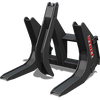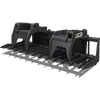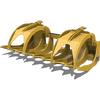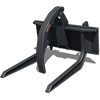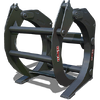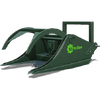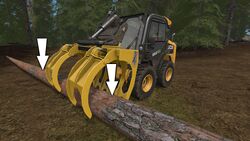Log Forks/Farming Simulator 17
A Log Fork is a type of Loading Tool in Farming Simulator 17. A Log Fork has a base (usually two teeth or a scoop-like platform) that can scoop up one or more Logs from the ground, and a hydraulic jaw that can close on command to hold the logs tightly in its grip. It can then lift the logs up and carry them elsewhere, or place them onto a Log Transport or Train.
Log Forks are not the only way to pick up logs, but they are by far the cheapest. Once more money becomes available, Log Forks may become obsolete in favor of Log Transports that have their own crane arm - which can pick up and move logs much more easily. Gigantic (and extremely expensive) Tree Harvesters can cut down trees, strip them of branches, and carry them elsewhere - rendering Log Forks nearly useless.
The base game offers five different models of Log Forks, and one Tree Cutter/Log Fork hybrid. Each model is designed to be fitted on a different type of Loader. The size of a Log Fork is its most important attribute, as a larger fork can carry more logs at once. Another important difference is the width of the base of the fork; A wider base gives more stability once the log has been lifted from the ground.
List of Log Forks
The following is a list of all Log Forks found in the base game. Note that each Log Fork is found in a different category at the Store, and can only be fitted to one specific type of Loader or other vehicle.
| Name | Price | Maint. Cost per Day |
Weight | Attachment |
|---|---|---|---|---|
| Stoll Log Fork | 800 | 5 | 597 | Front Loading Arm |
| JCB Log Fork | 1,200 | 5 | 1,159 | Skid Steer Loader |
| DFM TG84 | 1,400 | 5 | 523 | Skid Steer Loader |
| Magsi Telehandler Log Fork | 3,400 | 5 | 495 | Telehandler |
| Magsi Wheel Loader Log Fork | 3,800 | 5 | 671 | Wheel Loader |
| DFM TR3200 | 5,400 | 20 | 355 | Three-point hitch |
Notes for Table
- The DFM TR3200 is a combination Tree Cutter / Log Fork. Its ability to cut trees down gives it a strong advantage, but it is the smallest Log Fork in the game, and cannot be used to lift logs into transports at all.
Working with Log Forks
As their name suggests, Log Forks are specifically designed to lift and carry Logs - Trees that have already been cut down by another machine.
The Log Fork has a "Base" part which is used to scoop the logs up off the ground. Typically the base is a pair of tines (teeth) that can be lowered to ground level and then pushed underneath the log. On some models, the base is a flat scoop-like plate with sharp teeth at the front, but it is generally used the same way. Once the log is on the base, you can manually close the upper part of the Log Fork - the "Jaw" - to tightly grip the log and keep it from falling out. Once the log is gripped, you can lift the Log Fork and move it elsewhere, or lift it up and drop it into a Log Transport, Wood Chipper, etc.
Getting the log on the fork is harder than it sounds, because the ground in Farming Simulator 17 is completely solid. In real life, a Log Fork can "dig in" under the log, but this is not possible in the game. As a result, the Log Fork may sometimes push the log instead of wedging underneath it. To counter this problem, consider pushing the log into a tree or other solid obstacle so that the log has nowhere to go and has to roll onto the base.
Another method that might be easier to use is to lift logs from above. Instead of trying to slide the base of the fork underneath the log, use the fork's base and jaw as a sort of pincer. To do this, raise the Log Fork above the log, and angle it down; then open the jaw, lower the Log Fork onto the log, and close the jaw. This method ensures that the log won't roll away. However, some models of Log Forks are not well designed for this, and will struggle trying to lift very thin or very thick logs this way.
Always try to lift a log by holding it at its center (or better yet, at its center of mass). If you try to lift a log from one of its ends, the whole thing may become imbalanced and could even flip your Loader.
Other than lifting logs into transports or arranging them in a neat pile, lifting a fallen tree also makes it a lot easier to strip its branches off with a Chainsaw. By lifting the log with your fork a small distance off the ground, you expose all the branches that would otherwise be unreachable below the ground. Lifting it up exposes all the branches, and a chainsaw can easily lop them off. Obviously, if you're using an advanced Tree Harvester that automatically strips off branches, you won't have any branches to deal with.
Finally, note that it is often easier (and faster) to lift several logs simultaneously instead of one-by-one. A typical log fork can hold several thinner logs and carry them together, if the vehicle is not too light. Therefore, try to pile your logs up in one place, parallel to one another, so they can be lifted in bunches.
Comparison with other Tools
Log Forks are the only Loading Tools specifically designed for lifting Logs. Nonetheless, some Manure Forks may also be capable of lifting logs in much the same way as Log Forks do. Additionally, large (and expensive) Log Transports come with their own built-in crane arm which is significantly better at lifting logs.
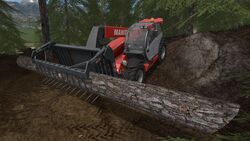
Many Manure Forks are built the same way as Log Forks: They have a base part that can slide underneath the log, and a jaw that can be closed to lock the logs in place. Not all Manure Forks are built like this, and some Manure Forks that do have a hydraulic jaw cannot lift Logs anyway (such as the Stoll Silage Cutter. However, if you are short on money and can't afford a Log Fork, you might want to check whether your Manure Forks can do the job.
The largest and most expensive Log Transports, such as the Stepa FHL 13 AK or Ponsse Buffalo, come with their own crane arm. This arm has a claw at the end that can lift logs and move them into the Transport. A crane arm is significantly better at picking up logs - individually or in bunches - and have better controls for placing them carefully into the transport itself. They are overall superior to Log Forks, with two caveats: They cost a whole lot more, and they cannot maneuver as easily inside a dense forest.

Finally, note that there are several other tools that can lift logs, assuming you have the necessary skills. For example, the DFM CFB-16 (a Tree Cutter) can use its grabbing arms to lift a log off the ground. Tree Harvesters can move logs or even place them into a transport immediately after cutting the tree, but they cannot lift the log again after it has already been placed down on the ground.

